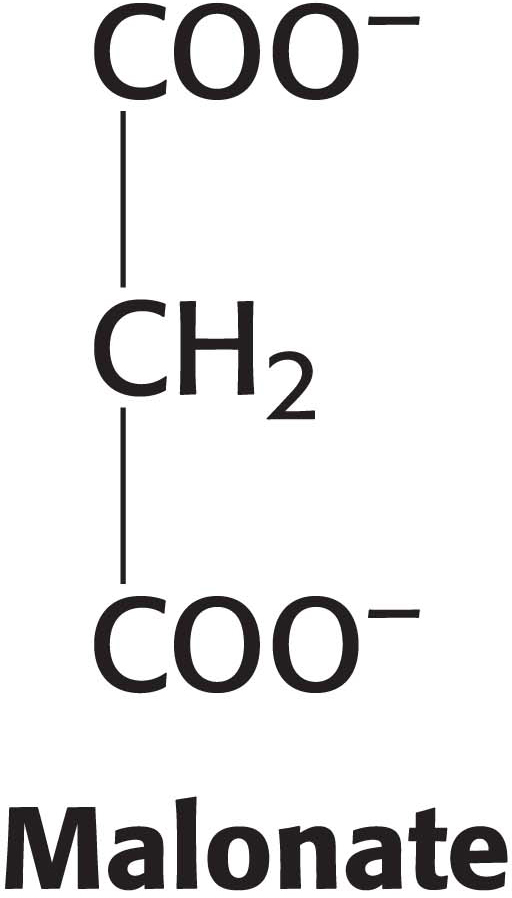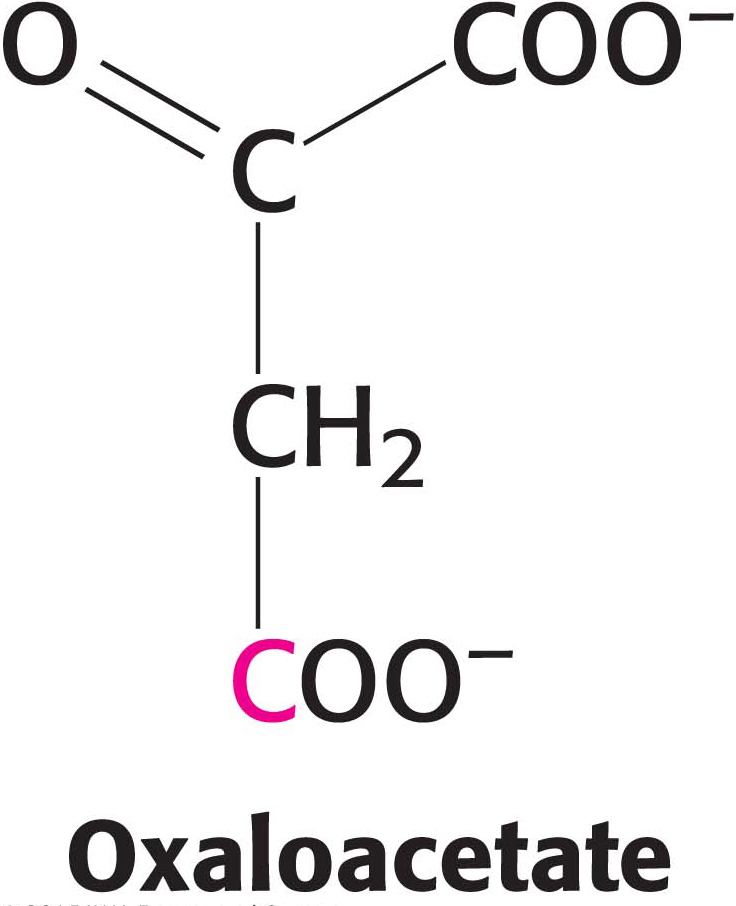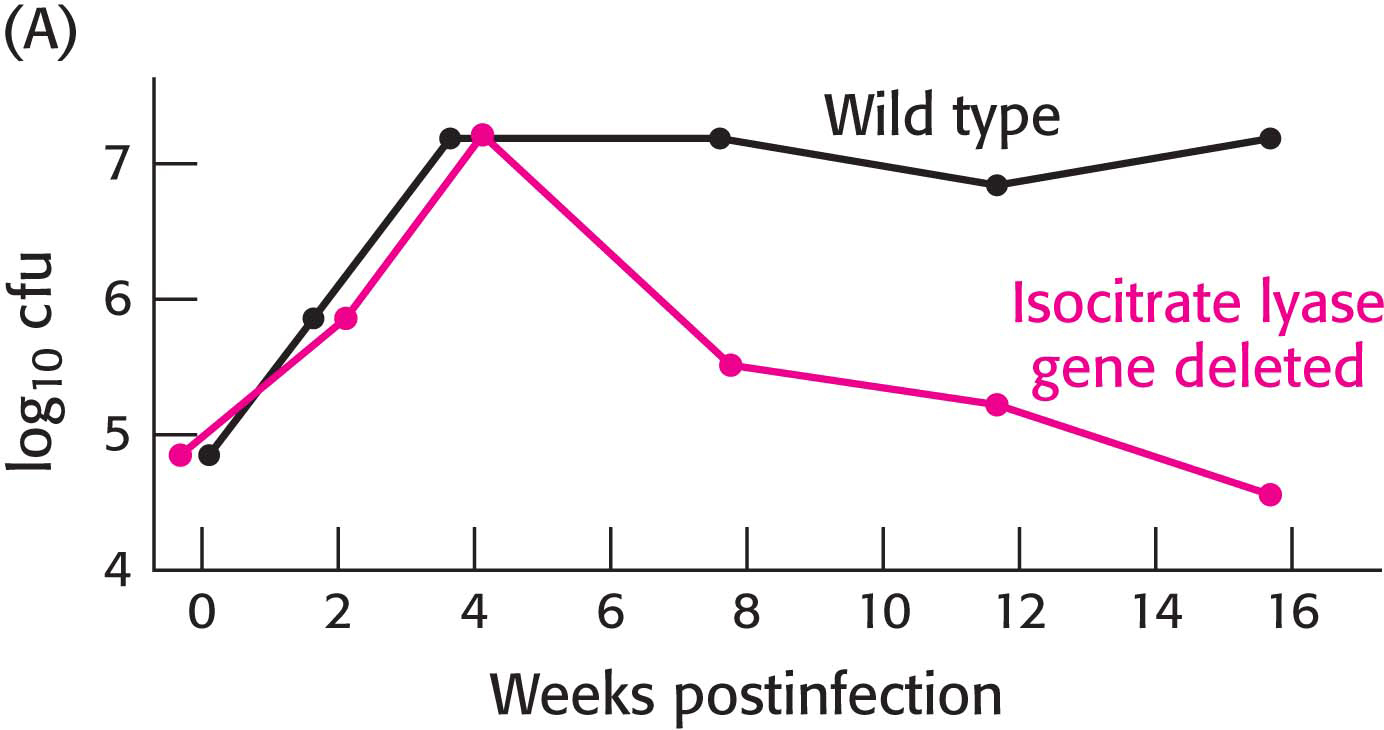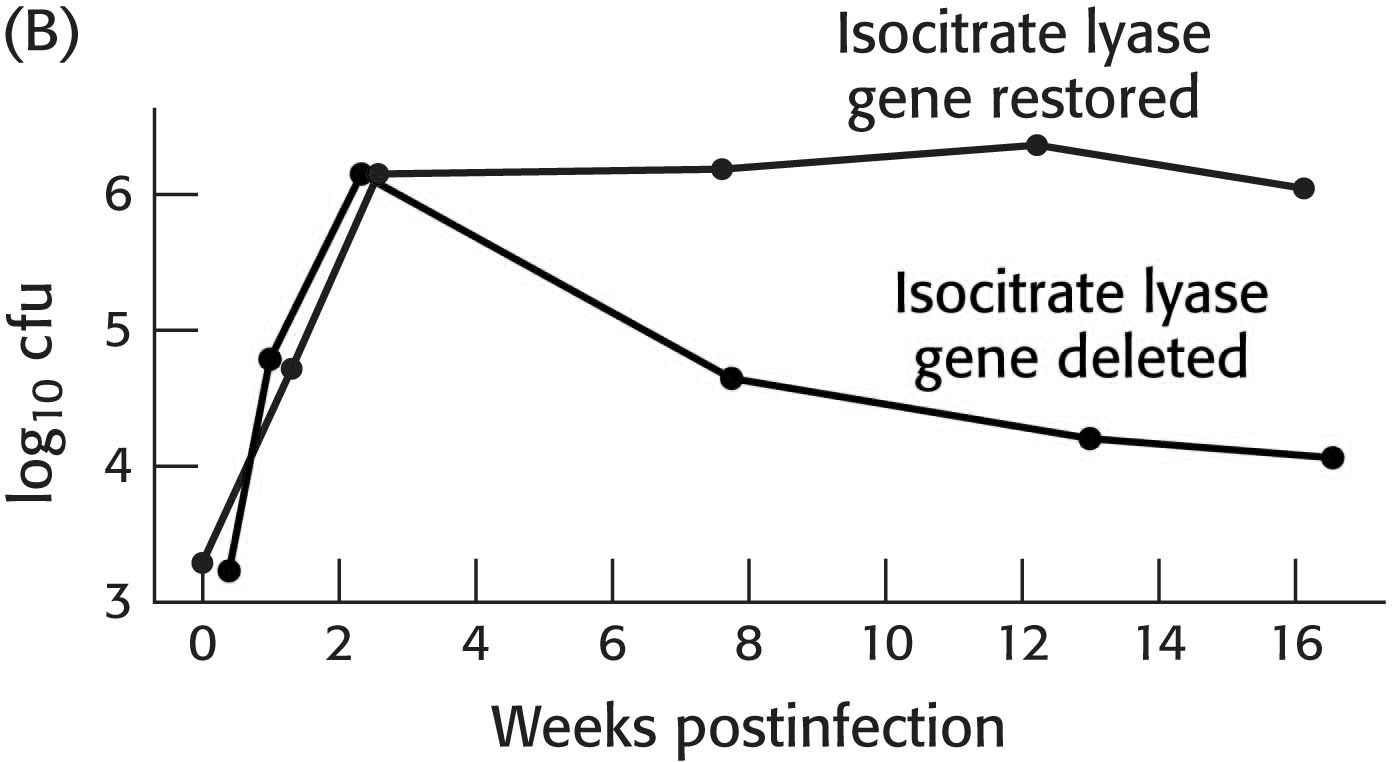PROBLEMS
Question 19.1
1. The bottom line. What is the net equation of the citric acid cycle? ✓ 3
Question 19.2
2. A hoax, perhaps? The citric acid cycle is part of aerobic respiration, but no O2 is required for the cycle. Explain this paradox. ✓ 3
Question 19.3
3. Thing 1 and Thing 2. The citric acid cycle can be thought of as taking place in two stages. What are the two stages? ✓ 3
Question 19.4
4. Like Jack and Jill. Match each enzyme with its description.
Pyruvate dehydrogenase complex Citrate synthase Aconitase Isocitrate dehydrogenase α-Ketoglutarate dehydrogenase Succinyl CoA synthetase Succinate dehydrogenase Fumarase Malate dehydrogenase Pyruvate carboxylase | Catalyzes the formation of isocitrate Converts pyruvate into acetyl CoA Catalyzes the formation of α-ketoglutarate Condenses oxaloacetate and acetyl CoA Generates ATP Generates malate Catalyzes the formation of oxaloacetate Converts pyruvate into oxaloacetate Synthesizes succinyl CoA Synthesizes fumarate |
Question 19.5
5. One from two. The synthesis of citrate from acetyl CoA and oxaloacetate is a biosynthetic reaction. What is the energy source that drives the formation of citrate? ✓ 3
Question 19.6
6. A penny saved … How is the wasteful hydrolysis of acetyl CoA prevented by citrate synthase? ✓ 3
Question 19.7
7. C2 + C2 → C4.
(a) Which enzymes are required to get the net synthesis of oxaloacetate from acetyl CoA? ✓ 6
(b) Write a balanced equation for the net synthesis.
(c) Do mammalian cells contain the requisite enzymes?
Question 19.8
8. Driving force. What is the value of ΔG°′ for the complete oxidation of the acetyl unit of acetyl CoA by the citric acid cycle? ✓ 4
Question 19.9
9. Acting catalytically. The citric acid cycle itself, which is composed of enzymatically catalyzed steps, can be thought of as essentially a supramolecular enzyme. Explain. ✓ 4
Question 19.10
10. Seven o’clock roadblock. Malonate is a competitive inhibitor of succinate dehydrogenase. How will the concentrations of citric acid cycle intermediates change immediately after the addition of malonate? Why is malonate not a substrate for succinate dehydrogenase? ✓ 4

Question 19.11
11. One of a kind. How is succinate dehydrogenase unique compared with the other enzymes in the citric acid cycle?
Question 19.12
12. Phosphate requirement. What step in the citric acid cycle requires a molecule of inorganic phosphate? ✓ 3
Question 19.13
13. An added bonus. What reaction in the citric acid cycle results in the direct formation of a molecule of ATP? ✓ 3
Question 19.14
14. Regulators. Which enzymes are the key regulatory enzymes of the citric acid cycle itself? ✓ 5
Question 19.15
15. Versatility. What is the chief benefit of being able to perform the glyoxylate cycle?
Chapter Integration Problem
Question 19.16
16. Kissin’ cousins. How does the decarboxylation of α-ketoglutarate resemble that of pyruvate decarboxylation?
Question 19.17
17. Fats into glucose? Fats are usually metabolized into acetyl CoA and then further processed through the citric acid cycle. In Chapter 17, we learned that glucose could be synthesized from oxaloacetate, a citric acid cycle intermediate. Why, then, after a long bout of exercise depletes our carbohydrate stores, do we need to replenish those stores by eating carbohydrates? Why do we not simply replace them by converting fats into carbohydrates?
Question 19.18
18. No signal, no activity. Why is acetyl CoA an especially appropriate activator for pyruvate carboxylase? ✓ 5
Mechanism Problems
Question 19.19
19. Symmetry problems. In experiments carried out in 1941 to investigate the citric acid cycle, oxaloacetate labeled with 14C in the carboxyl carbon atom (shown in red below) farthest from the keto group was introduced into an active preparation of mitochondria.
Analysis of the α-ketoglutarate formed showed that none of the radioactive label had been lost. Decarboxylation of α-ketoglutarate then yielded succinate devoid of radioactivity. All of the label was in the released CO2. Why were the early investigators of the citric acid cycle surprised that all of the label emerged in the CO2?
Question 19.20
20. Symmetric molecules reacting asymmetrically. The interpretation of the experiments described in problem 19 was that citrate (or any other symmetric compound) cannot be an intermediate in the formation of α-ketoglutarate, because of the asymmetric fate of the label. This view seemed compelling until Alexander Ogston incisively pointed out in 1948 that “it is possible that an asymmetric enzyme which attacks a symmetrical compound can distinguish between its identical groups.” For simplicity, consider a molecule in which two hydrogen atoms, a group X, and a different group Y are bonded to a tetrahedral carbon atom as a model for citrate. Explain how a symmetric molecule can react with an enzyme in an asymmetric way.
Challenge, Data Interpretation, and Chapter Integration Problems
Question 19.21
21. A little goes a long way. As will become clearer in Section 9, the activity of the citric acid cycle can be monitored by measuring the amount of O2 consumed. The greater the rate of O2 consumption, the faster the rate of the cycle. Hans Krebs used this assay to investigate the cycle in 1937. He used as his experimental system minced pigeon-
|
Effect of citrate on oxygen consumption by minced pigeon- |
||
|---|---|---|
|
|
Micromoles of oxygen consumed |
|
|
Time (min) |
Carbohydrate only |
Carbohydrate plus 3 μmol of citrate |
|
10 |
26 |
28 |
|
60 |
43 |
62 |
|
90 |
46 |
77 |
|
150 |
49 |
85 |
(a) How much O2 would be absorbed if the added citrate were completely oxidized to H2O and CO2?
(b) On the basis of your answer to part a, what do the results given in the table suggest?
Question 19.22
22. Arsenite poisoning. The effect of arsenite on the experimental system of problem 21 was then examined. Experimental data (not presented here) showed that the amount of citrate present did not change in the course of the experiment in the absence of arsenite. However, if arsenite was added to the system, different results were obtained, as shown in the following table. ✓ 4
|
Disappearance of citric acid in pigeon- |
||
|---|---|---|
|
Micromoles of citrate added |
Micromoles of citrate found after 40 minutes |
Micromoles of citrate used |
|
22 |
00.6 |
21 |
|
44 |
20.0 |
24 |
|
90 |
56.0 |
34 |
(a) What is the effect of arsenite on the disappearance of citrate?
(b) How is the arsenite’s action altered by the addition of more citrate?
(c) What do these data suggest about the site of action of arsenite?
Question 19.23
23. Isocitrate lyase and tuberculosis. The bacterium Mycobacterium tuberculosis, the cause of tuberculosis, can invade the lungs and persist in a latent state for years. During this time, the bacteria reside in granulomas—
In graph A, the black data points represent the results for wild-
(a) What is the effect of the absence of isocitrate lyase?
The gene encoding isocitrate lyase was reinserted into bacteria from which it had previously been deleted (Chapter 41 describes the reinsertion technique.) In graph B, black data points represent bacteria into which the gene was reinserted and red data points represent bacteria in which the gene was still missing.
[Data for graphs A and B after J. D. McKinney, K. höner zu Bentrup, e. J. Muñozelias, et al., Nature 406:735–
(b) Do these results support those obtained in part a?
(c) What is the purpose of the experiment in part b?
(d) Why do these bacteria perish in the absence of the glyoxylate cycle?
Challenge Problems
Question 19.24
24. Flow of carbon atoms. What is the fate of the radioactive label when each of the following compounds is added to a cell extract containing the enzymes and cofactors of the glycolytic pathway, the pyruvate dehydrogenase complex, and the citric acid cycle? (The 14C label is printed in red.) ✓ 3
(a)  (b)
(b) 
(c)  (d)
(d) 
(e) Glucose 6-
Question 19.25
25. Coupling reactions. The oxidation of malate by NAD+ to form oxaloacetate is a highly endergonic reaction under standard conditions (ΔG°′ = 29 kJ mol−1, or 7 kcal mol−1). The reaction proceeds readily under physiological conditions.
(a) Why?
(b) Assume an [NAD+]/[NADH] ratio of 8 and a pH of 7, and give the lowest [malate]/[oxaloacetate] ratio at which oxaloacetate can be formed from malate.
Question 19.26
26. Power differentials. As we will see in the next chapter, when NADH reacts with oxygen, 2.5 ATP are generated. When FADH2 reduces oxygen, only 1.5 ATP are generated. Why then does succinate dehydrogenase produce FADH2 and not NADH when succinate is reduced to fumarate?
Question 19.27
27. Back to Orgo. Before any oxidation can take place in the citric acid cycle, citrate must be isomerized into isocitrate. Why?
Question 19.28
28. Synthesizing α-ketoglutarate. With the use of the reactions and enzymes considered in this chapter and in Chapter 18, pyruvate can be converted into α-ketoglutarate without depleting any of the citric acid cycle components. Write a balanced reaction scheme for this conversion, showing cofactors and identifying the required enzymes. ✓ 6
Selected Readings for this chapter can be found online at www.whfreeman.com/